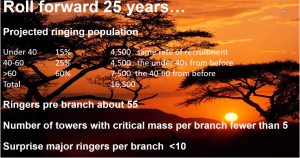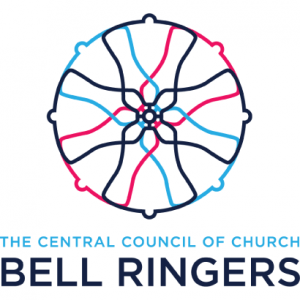The first in a series of articles detailing the results of a branding collaboration with Yellowyoyo.
Former Central Council President Simon Linford launched the ‘Ringing 2030’ project at the 2022 Council meeting, saying that with the pandemic having had a critical impact on ringing we really need to address the long running demographic trends of ringing if we want ringing to survive into the future. Since then, a pilot survey of ringing introduced to the Council by Tristan Lockheart showed 75% of respondents were in the 51-80 age bracket. The can has been kicked down the road for too long and now we really need to do something about it.
Marketing and branding project launched
While there are many parts to Ringing 2030, and the new Central Council strategy is based on progressing it, one of the first steps of the project is to look at how we can attract more people to ringing and make it easier for bands to recruit. We want to look at how ringing is branded and marketed – what will make it attractive to the sorts of people who are likely to enjoy it, stick at it, and be good at it? How do we catch the attention of the younger audience in a social media driven world? How do we continue to attract people to ringing when the Church can no longer do it for us? Can we entice back some of those thousands of lapsed ringers who could be so valuable to local bands?
This has been considered before. In 2014, John Harrison and Rob Parker lead a project with Reading University to look at the branding and visual identity of ringing which resulted in a proposal called ‘Resound’. It was never followed through by the Council and the proposal remained on the shelf. The brief this time is similar to the one written back then, although the world has moved on and there are very different ways of getting to our target audience then there were then.
The cost of doing nothing
The problem is brought into stark relief by considering a couple of slides that Simon used in his Ringing 2030 talk at this year’s Council meeting. That talk was filmed and is well worth watching if you have time: view the YouTube video of the presentation. A few of the Representatives at the meeting intend to show it to their association committees both as food for thought and as a call to action.
While previous surveys and the Ringing Trends Committee have looked at ringing demographics and the future of ringing in great detail, the analysis in Simon’s presentation really got people thinking. To a certain extent it was done on the back of an envelope, i.e. the numbers are not precise or based on survey data, but the numbers paint a picture that seems to be about right.
The first slide looks at the current demographic profile of ringing, and Simon made the point that the current active ringing population is a result of the young ringers who were taught in the 1980s and 1990s and who are still ringing. He remembered there being far more young ringers then than there are now so we cannot afford to have the same attrition rate.
So, the current demographic profile is something like this image:

Looking at the number of ringers per tower and branch is important because without critical mass, ringing can’t develop or even happen at all. Following the pandemic, anecdotal evidence suggests that most towers had lost one or two ringers. In itself that doesn’t sound like too many, but if those ringers are lost from a tower which is on the edge of viability anyway, that can tip that tower over the edge; the loss of a couple could actually cause an entire band to collapse. This has definitely happened in some places. So, critical mass of ringers per tower and branch is important if we are to continue the current general model of bands of ringers associated with particular towers, organised in branches or districts.
Looking at the number of Surprise Major ringers per branch is not suggesting being able to ring Surprise Major is the be all and end all, but rather it is an indicator of experience, with experienced ringers being needed to help others progress. Lose that experience and things get much more difficult.
What happens if we do nothing? It looks like this:

The current crop of under 40s goes into the 40-60 bracket. There will be some who give up, there will be some recruitment of ringers in this age bracket anyway, and some returning ringers, but overall it’s probably fair to assume it stays about the same. Then the same rate of recruitment of the under 40s would keep that total the same as it is now (at best). The current 40-60 cohort becomes the over 60s, maybe even enjoying retirement unless they actually have to keep working until they’re 80, and the current over 60s, who actually provide the majority of active peal ringers and leaders today, drop away.
That brings the current ringing population from about 30,000 to a projected 16,500.
Take a look at all the data in a tabular format:
| Age | Percentage | Approximate numbers now | Numbers in 25 years | Comments |
|---|---|---|---|---|
| under 40 | 15% | 4500 | 4500 | Assuming same rate of recruitment |
| 40-60 | 25% | 7500 | 4500 | The under 40s become the 40-60 in 25 years' time |
| 60 and over | 60% | 18000 | 7500 | the over 60s are the 40-60 from 25 years ago. |
| Key | Now | In 25 years |
|---|---|---|
| Average ringers per branch (assuming 300 branches | 100 | 55 |
| Towers with critical mass of ringers per branch | 10 | less than 5 |
| Surprise Major ringers per branch | about 20l | less than 10 |
What does that do to critical mass? It has a critical impact on viability of many bands, so the current structure will probably no longer work. Few towers will have enough ringers on their own, and there will be very little experience to go round. Method ringing will become increasingly urban. Towns and cities, particularly those with universities, will continue to thrive, while ringing in more rural areas could die out.
The appointment of Yellowyoyo
The ringing community may have the expertise to do this work itself, however there are many benefits to bringing in an external expert partner because they can see ringing from a non-ringer perspective and understand how to describe the attractions of ringing to new audiences. For many years the Council has sat on financial reserves. Given there is nothing really more important than making sure there are enough bellringers, investing in the marketing of ringing has to be a top priority and a good use of the Council’s resources.
Around a year ago, a team bringing together experience on marketing and ringing went through a selection process to find an external partner to help with this work, resulting in the appointment of a company called Yellowyoyo. This was a company that Elva Ainsworth has worked with professionally for many years and with whom she first discussed marketing bellringing 10 years ago!
There is an old adage in advertising and marketing that half your expenditure is wasted – the problem is knowing which half. A major part of the project therefore is to make sure that with limited resources we are targeting our efforts at demographics and types of people who we think will make good and useful bellringers, maximising the return on the effort of our limited bank of ringing teachers.
What next?
In the next article we will explain the process Yellowyoyo went through to understand the brief and understand ringing.
Tina Stoecklin, President
Vicki Chapman, Deputy President
Central Council of Church Bell Ringers
This article was originally published in The Ringing World issue 5866 (29th September)
Send to a friend

